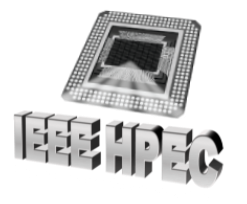


© Lorem Ipsum Dolor 2010
2012 IEEE High Performance
Extreme Computing Conference
(HPEC ‘12)
Sixteenth Annual HPEC Conference
10 - 12 September 2012
Westin Hotel, Waltham, MA USA














HPEC Tutorial: High Performance Computing: Embedded and Distributed Systems
WE ARE NO LONGER ACCEPTING REGISTRATIONS FOR THIS TUTORIAL, AS IT
IS SOLD OUT.
Authors: David Martinez, Robert Bond, Michael Vai
MIT Lincoln Laboratory
Abstract
In the last several years, there has been significant emphasis on advancing processing to most effectively convert data into
knowledge. This tutorial presents an overview of applications demanding real-time embedded and distributed computing, an
introduction to hardware and software implementation techniques, recent advances in hardware and software standards to
achieve rapid technology insertion, and a look into observed computing trends.
Network-centric warfare implies leveraging information from multiple assets in-theater. However, communicating sensor data
without significant processing on board the sensor platform would completely clog the available and future communication
bandwidth. The complexity of sensors, with data rates exceeding hundreds of billion bytes per second (driven by analog-to-
digital converter sampling rates), leads to massive amounts of data. Therefore, on-board computation is necessary to reduce
data rates and to transform sensor data into information. This information from ground, air, and space assets will then be routed
across the theater and globally to permit extracting the requisite knowledge needed by our warfighters. The tutorial focuses on
the embedded and distributed real-time computing to transform data into actionable knowledge.
The tutorial will start by reviewing example applications demanding significant computing capabilities. These applications will
highlight typical computation, communication, and memory requirements, constrained to implementations with stressing low size,
weight, and power goals. After setting the application domain and on-board complexity drivers, implementation options are
reviewed. The options range from application-specific integrated circuits (ASICs), field programmable gate arrays (FPGAs),
digital signal processors (DSPs), and general purpose processors. The tutorial concludes with an introduction to embedded
software practices and techniques. Particular emphasis is put on emerging software middleware standards and open system
architectures for real-time systems. The tutorial will also cover the emerging challenges and approaches for adapting sensors to
operate in a network-centric context. Examples of enterprise architectures leveraging commercial advances in cloud computing
will be presented.
This tutorial is designed for system designers, algorithm developers, hardware and software designers, and program managers
interested in an overview and introduction to real-time embedded and distributed computing. The tutorial content will also
address emerging trends in hardware, software, and rapid prototyping techniques. The tutorial draws from the authors’ over fifty
years of combined experience in these areas.
“This work is sponsored by the Assistant Secretary of Defense for Research & Engineering under Air Force Contract #FA8721-
05-C-0002. Opinions, interpretations, conclusions and recommendations are those of the author and are not necessarily
endorsed by the United States Government.”
Site created and maintained by Ballos Associates








